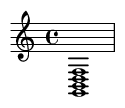Mastering the 7#11 Chord: A Comprehensive Guide
The 7#11 chord, also known as the dominant seventh sharp eleven, is a rich and colorful extended chord that adds a unique flavor to harmonic progressions. This chord is widely used in jazz, fusion, and contemporary music to create tension and harmonic interest.
Definition and Explanation


The 7#11 chord is a dominant seventh chord with an added sharp eleventh (or augmented fourth). The basic formula is:
- Root
- Major third
- Perfect fifth
- Minor seventh
- Sharp eleventh (#11)
In chord symbols, it's typically written as 7#11 (e.g., C7#11) or sometimes as 7(#11).
Historical Context and Musical Significance
The 7#11 chord emerged prominently in 20th century jazz, particularly in the bebop and post-bop eras. It's strongly associated with the Lydian dominant scale (the fourth mode of melodic minor), which gives it its characteristic #11 sound. This chord became a staple in the harmonic language of composers like Wayne Shorter and Herbie Hancock.
Technical Construction
Interval Structure
The intervals that make up a 7#11 chord are:
- Root (1)
- Major third (3) - 4 semitones above root
- Perfect fifth (5) - 7 semitones above root
- Minor seventh (b7) - 10 semitones above root
- Sharp eleventh (#11) - 6 semitones above the octave (18 semitones above root)
Chord Formula
The formula can be expressed as: 1 - 3 - 5 - b7 - #11
Common Voicings
On piano, common voicings include:
- Rootless: 3 - #11 - b7 - 9 (right hand)
- Spread: Root (LH) - 3 - b7 - #11 (RH)
On guitar, common shapes include:
- X-5-4-5-6-X (C7#11)
- X-X-5-5-6-6 (G7#11)
Practical Applications
Jazz Usage
In jazz, the 7#11 is frequently used:
- As a dominant chord resolving down a fifth (G7#11 → Cmaj7)
- In tritone substitutions (Db7#11 instead of G7)
- As a static dominant (holding on the V chord)
Classical Context
While less common in classical music, you can find similar sonorities in:
- Late Romantic period (Scriabin, Debussy)
- 20th century composers (Stravinsky, Bartók)
Pop and Rock Examples
Used more sparingly in these genres, but appears in:
- Steely Dan's "Aja"
- Jamiroquai's "Virtual Insanity"
- Radiohead's harmonic vocabulary
Progressive Exercises
Level 1: Construction
Build 7#11 chords on all 12 roots, using closed position voicings.
Level 2: Voice Leading
Practice resolving 7#11 chords to their tonic (G7#11 → Cmaj7) with smooth voice leading.
Level 3: Improvisation
Improvise over static 7#11 chords using the Lydian dominant scale.
Level 4: Reharmonization
Take standard jazz progressions and substitute appropriate chords with 7#11.
Common Progressions
Here are some typical uses of the 7#11 chord:
- II - V - I with altered dominant: Dm7 - G7#11 - Cmaj7
- Tritone substitution: Dm7 - Db7#11 - Cmaj7
- Static dominant vamp: G7#11 - G7#11 - G7#11
Conclusion
The 7#11 chord is a versatile harmonic color that can add sophistication and tension to your playing. By mastering its construction, voice leading, and applications across genres, you'll significantly expand your harmonic palette.
Historical Context and Musical Significance
Emerging during the bebop era of the 1940s, the 7#11 chord became a staple in jazz harmony as musicians like Dizzy Gillespie and Thelonious Monk explored extended dominants. This chord gained prominence through its dual functionality: creating harmonic tension while avoiding the "avoid note" (natural 11th) in major scale harmony. Its distinctive Lydian-dominant sound (#11 acting as the #4 scale degree) made it essential for V7 chords in major keys, particularly when resolving to tonic chords. The #11 alteration provides a brighter, more complex alternative to the standard dominant 7th, allowing composers to imply the Lydian dominant scale (5th mode of melodic minor). Historically significant recordings like Miles Davis' "Milestones" and Herbie Hancock's "Maiden Voyage" showcase its textural richness and tension-building capabilities.
Progressive Exercises
Beginner
Practice root-position voicings in all keys. Start with shell voicings (3rd-7th-#11) in closed position:
- C7#11: C-E-B-F# (RH: E-B-F#)
- Voice leading: Resolve to Fmaj7 (C-E-B-F# → F-A-E-C)
Intermediate
Incorporate upper structures in context:
- II-V-I progression: Dm7 → G7#11 (voiced G-F-B-E) → Cmaj7
- Practice drop-2 voicings: G7#11 (low to high: G-F-B-E)
Advanced
Tritone substitution and modal interchange:
- Substitute Db7#11 for G7#11: Voiced Db-F-B-E (enharmonic to G7#11's 3rd-7th)
- Apply in minor: Cm7 → F7#11 → Bbmaj7#11 (borrowed from parallel major)
Ear Training Tips
Develop recognition through targeted listening:
- Interval Identification: Isolate the #11-to-root tritone (e.g., F#-C in C7#11)
- Chord Comparisons: Contrast C7 (C-E-G-Bb) vs. C7#11 (C-E-G-Bb-F#)
- Progression Drills: Use apps like EarMaster to practice identifying 7#11 in II-V-I contexts
- Singing Exercise: Arpeggiate C7#11 as C-E-G-Bb-F#, emphasizing the #11's dissonance
Reference tracks: Listen for 7#11 in McCoy Tyner's "Passion Dance" (0:45) and Steely Dan's "Aja" (chorus sections).
Common Usage in Different Genres
Jazz
Primary function as altered dominant: Creates tension before resolution (e.g., G7#11 → Cmaj7 in "Giant Steps"). Used in modal jazz for static harmony (Miles Davis' "So What" vamps).
Fusion
Adds harmonic complexity in extended solos: Jaco Pastorius often used F#7#11 in Weather Report's "Birdland" transitions.
R&B/Soul
As passing chord: Stevie Wonder's "Isn't She Lovely" verse (B7#11 resolving to E)
Film Scoring
Emotional ambiguity: Thomas Newman's "American Beauty" score uses Eb7#11 for unsettling textures.
Progressive Rock
Modulation tool: Yes' "Roundabout" employs D7#11 for key shifts.
Online Resources
- Open Studio Jazz: Altered Dominant Masterclass (YouTube)
- Jazz Advice: "7#11 Chord Application Guide" (website)
- Teoria.com: Interactive chord ear training
Academic Papers
- "The Evolution of Extended Harmony in Post-Bop" (Jazz Research Journal)
Historical Context and Musical Significance
The 7#11 chord emerged during jazz's harmonic evolution in the mid-20th century, particularly through innovators like McCoy Tyner and Herbie Hancock. This chord represents the Lydian dominant scale (5th mode of melodic minor), creating a unique blend of major-third brightness with #11's dissonant lift. Its significance lies in resolving tritone tension while avoiding tonal ambiguity – the #11 simultaneously clashes with the perfect fifth (creating tension) and reinforces the dominant function through its augmented fourth relationship with the root. Historically, it became essential in modal jazz for its ability to imply harmonic movement without traditional cadences. Miles Davis' "Milestones" (1958) demonstrates early usage where the #11 adds modernist coloration while maintaining forward motion toward tonic resolution.
Progressive Exercises
Beginner
Practice root-position voicings in all keys using minimal movement. Example in C: Left hand plays E-B♭ (3rd-7th), right hand plays G-D♯ (5th-#11). Cycle through circle of fifths. Focus on clean finger independence.
Intermediate
Voice-leading through ii-V-I progressions with #11 substitution. Example: Dm9 (D-F-A-C-E) → G7#11 (G-B-F-A♯) → CMaj9 (C-E-B-D). Practice in 12 keys with metronome at 60bpm.
Advanced
Reharmonize standards using 7#11 as: 1) Tritone sub (Db7#11 for G7), 2) Altered dominant, 3) Static harmony. Reharmonize "Autumn Leaves" A-section, replacing all dominants with 7#11 voicings using upper structure triads (e.g., E major over G7).
Ear Training Tips
Develop #11 recognition through contrast exercises: 1) Play dominant 7th vs 7#11 back-to-back, focusing on the "bluesy" versus "spacey" quality. 2) Sing the #11 against the chord root (e.g., F♯ over C7). 3) Use app-based drills: ChordCrush or EarMaster's "Altered Dominant" module. Transcribe iconic examples: Herbie Hancock's "Maiden Voyage" (2:15) where 7#11 chords create oceanic ambiguity, or Steely Dan's "Aja" (0:38) for fusion application. Practice identifying 7#11 in rootless voicings by listening for the characteristic clash between major 3rd and #11 (minor 9th interval).
Common Usage in Different Genres
- Jazz: As tritone substitute (e.g., Db7#11 for G7 in "Stella by Starlight") or for modal coloration in McCoy Tyner's "Passion Dance"
- Fusion: Static harmony beds in Weather Report's "Birdland" (0:45) creating atmospheric tension
- R&B/Soul: D'Angelo's "Untitled" uses F#7#11 in chorus for neo-soul sophistication
- Film Scoring: Thomas Newman employs 7#11 in "American Beauty" soundtrack for unsettling beauty
- Progressive Rock: Dream Theater's "The Dance of Eternity" (1:22) features rapid 7#11 changes for technical intensity
The chord adapts to genre contexts: In jazz, it drives functional harmony; in fusion, it creates textural planes; in pop, it adds sophisticated tension (see Jacob Collier's harmonizations).
